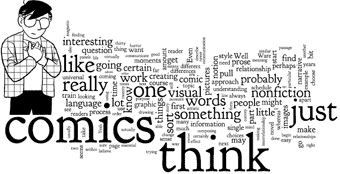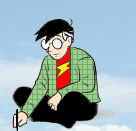March 24th, 2009
 Recent interview by Scot Hanson, boxed up and linked à la my old trails webcomics. Scot asked good questions, so I did my best to give him good answers—or will (it’s dated November 2009 at the top).
Recent interview by Scot Hanson, boxed up and linked à la my old trails webcomics. Scot asked good questions, so I did my best to give him good answers—or will (it’s dated November 2009 at the top).
Also online this week is an old interview from the family’s visit to University of Virginia during the 50 State Tour in 2007. Go here to download Issue #3 of the student-run Pulse Comic Zine for my interview.
Hey, great discussion on yesterday’s post, Everybody. Thanks!
March 23rd, 2009
Cartoonists are always finding ways to balance their pages. We can’t help it. If there’s a close-up in the lower left, we balance it a little on the upper right. If there are a lot of spot blacks on one page, we find more spots on the other. We’re taught that dynamic balance is more interesting than static balance, but the goal of balance itself remains. Balance can lead to harmonious, satisfying compositions, but is that what comics artists really want? A satisfying page is a page you can stay on, linger on, stop on—a page without momentum.
When we walk, all we’re doing is falling. We fall a little, stop ourselves from falling, then fall a little more. Balance keeps us from falling on our faces, but it’s imbalance that gets us where we’re going.
I wonder: Would it help to forget panel 1 when I draw panel 2, and forget 2 when I draw 3? The result might be an imbalanced mess, but would it also be a more interesting mess? A more surprising, less typical, mess? Would it lead the reader to wonder what the next spread had in store, and feel less confident he/she could predict the shape of each one?
Imbalance already drives stories forward—a character lacks something, the world’s out of joint, trouble’s on the rise—maybe it should also play a more prominent role in storytelling.
March 20th, 2009
Webcomics Weekend is upon us. I’m not there myself, but I figured I’d add to public service messages out there that registration is full, so don’t just show up at the door and expect to register.
Ditto for Comic Con hotels and four-day registration, but you probably already knew that.
I’m sure it’s annoying for spontaneous types, but trust me, it’s better than the reverse. I remember when there were a lot more empty patches in comics’ social arenas. I thought for sure that this would be the year that Comic-Con finally slowed down a bit, but maybe I was wrong. As for webcomics, give it a decade or two.
March 19th, 2009

The Canadian cable show “Prisoners of Gravity” from the late ’80s early ’90s has been showing up on YouTube lately. I’m in the third part of a Jack Kirby segment but you can find a lot of comic artists we all know as a bit worn/grizzled/bloated with age, showing up unnervingly young.
March 18th, 2009
 Larry Marder is collecting his amazing Beanworlds into gorgeous new volumes from Dark Horse. They feel heavy, blocky and wonderful. Soon there will be NEW Beanworlds and all the world will rejoice, but for now add this collection to your must-have list. It even includes my original introduction from almost exactly 20 years ago.
Larry Marder is collecting his amazing Beanworlds into gorgeous new volumes from Dark Horse. They feel heavy, blocky and wonderful. Soon there will be NEW Beanworlds and all the world will rejoice, but for now add this collection to your must-have list. It even includes my original introduction from almost exactly 20 years ago.
March 18th, 2009
 It’s almost funny watching a well-meaning journalist trying to cover all the different kinds of webcomics out there. Not an easy task these days.
It’s almost funny watching a well-meaning journalist trying to cover all the different kinds of webcomics out there. Not an easy task these days.
And with luck, it will only get harder.
March 17th, 2009
I first saw Microsoft’s Seadragon and Photosynth projects via Blaise Aguera y Arcas’s stunning demo at TED 2007, and of course, I immediately thought of the implications for my “infinite canvas” ideas. Apparently, I wasn’t alone. Last spring, I got an email from Ian Gilman who worked with the team, to let me know about his efforts to apply some of these ideas to comics and pointing out Seadragon’s baby steps on the Web. Though those efforts are only peripherally related to Seadragon so far, the proximity is interesting.

Art by Paul Sizer from his intro to B.P.M.
Microsoft’s Infinite Canvas, listed as “a funky side project” from Microsoft’s Live Labs, is still just in Alpha testing. It’s not as smooth as Merlin’s Tarquin Engine by any means, but it does introduce a community element and the instant gratification of being able to hit that “create” button and try it out right away, which could lead in some very interesting directions. I even threw a vintage improv up there to try it out.
The results are scattered, of course, and not every comic uses the same navigational model, but it’s definitely worth looking at and playing with.
March 16th, 2009
While working on layouts for the graphic novel, I’m trying out something a little different. I sketch out individual panels in sequence without any concern for how they’ll fall on the page. Instead, I’m first making sure the pacing and order is right—adding and subtracting moments as necessary—and then seeing how they tumble onto the page and whether adjustments have to be made after the fact.
So, basically I’m working out pacing like it was plain HTML, then the comics page is like a style sheet applied to that content. Comics = CSS!
This makes me happy.
Because I am a big fat dork.
March 14th, 2009

Just found out that the CBLDF had a Facebook page (yeah, I’m slow), but I noticed that they’d like to get 5,000 members and they’re already at 4,920 as I write this. Seems awfully close to me.
 Recent interview by Scot Hanson, boxed up and linked à la my old trails webcomics. Scot asked good questions, so I did my best to give him good answers—or will (it’s dated November 2009 at the top).
Recent interview by Scot Hanson, boxed up and linked à la my old trails webcomics. Scot asked good questions, so I did my best to give him good answers—or will (it’s dated November 2009 at the top). 


















